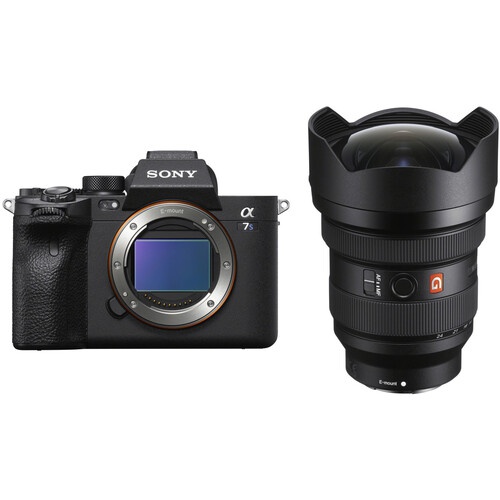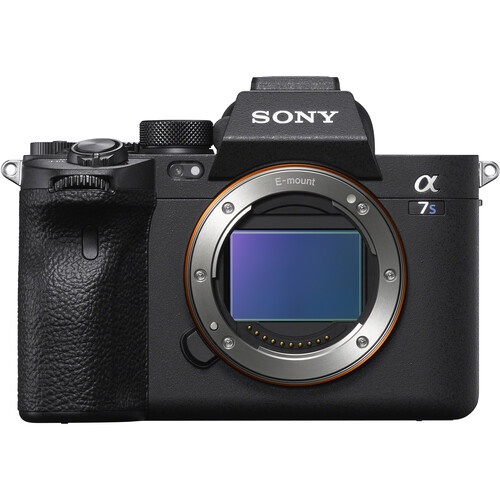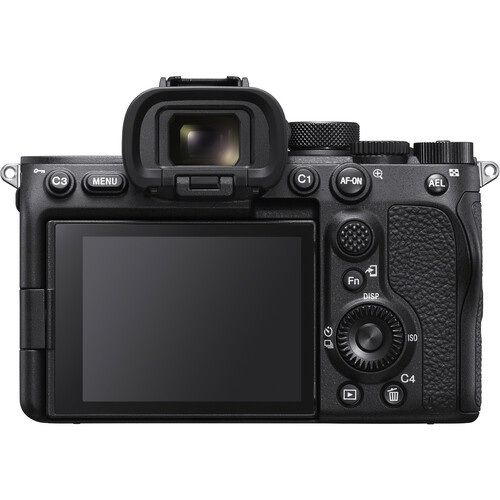
Sony a7S III Mirrorless Camera with 12-24mm f/2.8 Lens Kit
Inclusive of all taxes
View Shipping Details
 Free Shipping
Free Shipping 100% Secure Payments
100% Secure Payments 100% Genuine Product
100% Genuine ProductKnow more about this product
Why should I buy this?
Discover this product's exceptional qualities before buying.
Compare with other product
Comparing this product to any others that are comparable.
Get most popular reviews
Find product reviews for a better experience.
Where I can use this?
Understand the usability of the product.
Explore




| Lens Mount | Sony E |
| Sensor Type | 35.6 x 23.8 mm (Full-Frame) CMOS |
| Sensor Resolution | Actual: 12.9 Megapixel Effective: 12.1 Megapixel (4240 x 2832) |
| Crop Factor | None |
| Aspect Ratio | 1:1, 3:2, 4:3, 16:9 |
| Image File Format | JPEG, Raw, HEIF |
| Bit Depth | 14-Bit |
| Image Stabilization | Sensor-Shift, 5-Axis |
A well-rounded bundle, the Sony a7S III Mirrorless Camera with 12-24mm f/2.8 Lens Kit from B&H pairs the full-frame video-optimized camera body with the FE 12-24mm f/2.8 GM ultra-wide zoom.
Sony a7S III Mirrorless Camera
Optimized video, optimized sensitivity, optimized speed, the Sony a7S III raises the bar for what a full-frame mirrorless camera is capable of. A revised 12.1MP Exmor R BSI CMOS sensor and updated BIONZ XR image processor offer faster performance, improved noise reduction, and a wider dynamic range, along with UHD 4K 120p video recording and internal 10-bit 4:2:2 sampling.
Video is the primary application of the a7S III, and improvements to the sensor and processor enable faster readout speeds and greatly reduced rolling shutter, along with high-bitrate internal recording, 16-bit raw output via the full-size HDMI port, and flexible control over motion with variable frame rate selection. The a7S III also does away with recording time limits and incorporates HLG for direct HDR production as well as S-Log2/S-Log3 gamma profiles for advanced HDR production with editing.
The updated sensor design also brings improved autofocus performance via 759 phase-detection points, which offer intelligent subject tracking and Real-time Eye AF to ensure critical focus on moving subjects in all recording modes. The sensor and BIONZ XR processor also facilitate impressive sensitivity, with an expanded range from ISO 40-409600, as well as fast 10 fps continuous shooting for up to 1000 consecutive raw frames. Additionally, 5-axis SteadyShot INSIDE sensor-shift image stabilization is available, too, which minimizes the appearance of camera shake by up to 5.5 stops.
Complementing the imaging assets, Sony has also made some changes to the a7S III's physical design, including a rear LCD with a side-open articulating design and an impressive 9.44m-dot OLED electronic viewfinder. The camera's menu system has also been updated for more intuitive navigation and the body design helps to promote better heat dissipation for improved continuous recording capabilities. Additionally, dual memory card slots both support working with CFexpress Type A or SD UHS-II memory cards for flexible and high-speed file storage.
12.1MP Exmor RS BSI CMOS Sensor and BIONZ XR Image Processor
A redesigned 12.1MP full-frame CMOS sensor now features a back-illuminated Exmor RS design in order to achieve improved clarity and reduced noise along with the expectedly impressive sensitivity, from ISO 80-102400 with an extended ISO 40-409600 range. The updated sensor design also yields 2x faster readout speeds than previous generations and, when coupled with the revised BIONZ XR image processor, greatly reduces rolling shutter by 3x and up to 8x faster processing and overall camera handling. The sensor and processor combination also helps to achieve a wide dynamic range, of up to approximately 14 stops for stills and 15 stops for video, and 10 fps continuous shooting for up to 1000 uncompressed raw files for stills.
UHD 4K 120p Video, 10-Bit 4:2:2 Internal Recording
Recording up to UHD 4K is possible with frame rates up to 120p, using full 1:1 pixel readout without binning. Internal 10-bit 4:2:2 sampling is also possible in all recording modes and, if recording externally via the full-size HDMI A port, 16-bit raw output is also possible for even greater tonal reproduction and post-production flexibility. Additionally, two codecs have also been developed: XAVC HS, which uses HEVC/H.265 encoding to retain more detail at smaller bitrates, and XAVC S-I, which is an intraframe codec for consistent performance and quality at bitrates up to 600 Mb/s.
The high-speed, 120 fps recording also enables 4x and 5x slow-motion movie recording with the frame rate playback set to either 30p or 24p or, if moving down to Full HD resolution, an effective 240p frame rate is also available for even greater motion control. Additionally, suiting long-form recording, the a7S III does not have any recording time limits to allow for unlimited clip lengths. The camera's physical design also features an improved heat-dissipating structure to promote longer possible recording times, up to an approximate 60-minute recording time at 4K60p.
Affording extensive customizable color and gamma controls, the a7S III allows users to adjust the gamma, black level, knee, color level, and more. S-Cinetone can be used to deliver distinct colors and healthy-looking skin tone rendering that matches the FX9 and FX6 cameras and is based on technology from the professional Cinema Line cameras, such as the VENICE. This color profile offers natural mid-tones, soft colors, and especially well-controlled highlights. Also, users can use the same S-Log2 Gamma Curve that is found on high end Sony Cinema cameras that squeezes up to 1300% more dynamic range into the video signal then traditional REC709, for increased post-production flexibility. HLG (Hybrid Log-Gamma) support is also available, along with the BT.2020 color space, for recording within a wide color gamut and, in addition to S-Log2, S-Log3 is also available for producing a 15+-stop dynamic range with increased grading control in the shadow to mid-tone regions of the image.
Fast Hybrid AF System
Covering 92% of the image area, a Fast Hybrid AF system incorporates 759 phase-detection points along with 425 contrast-detection areas for quick and precise focusing in a variety of lighting conditions with sensitivity down to -6 EV. This focusing system is available for use in all recording modes, to benefit both video and stills applications. Additionally, it is able to lock onto subjects quickly and can use Real-time Tracking for AI-based tracking on moving subjects or touch tracking for manual selection of the subject. Real-time Eye AF, suitable for both humans and animals, also ensures critical sharpness when shooting portraits. Helping to fine-tune how the focusing system performs, seven-step AF transition speed and five-step AF subject shift sensitivity controls let you refine how quickly focus shifts from point to point and how smoothly focusing shifts occur.
5-Axis SteadyShot INSIDE Image Stabilization
The a7S III incorporates an enhanced 5.5-stop effective 5-axis SteadyShot INSIDE image stabilization system, which compensates for five different types of camera shake encountered during handheld shooting of stills and video. This allows users to confidently use any lens, even adapted lenses, for critical imaging without encountering blur from camera shake.
For long focal lengths, the system will correct for pitch and yaw adjustments. Macro and high-magnification imagery, on the other hand, will benefit from the inclusion of horizontal and vertical shift compensation. All shooting styles will get usage out of the roll compensation. All 5 axes of stabilization will function at all times, even when used with third-party lenses and adapters or lenses with built-in optical stabilization.
Additionally, specifically for video, there is also an Active IS mode that adds even more precise stabilization methods for even smoother footage straight out of camera.
Body Design and Connectivity
- An impressive QXGA OLED Tru-Finder EVF features a high 9.44m-dot resolution and 0.9x magnification for exceptionally bright, clear, and detailed eye-level viewing. This viewfinder has a dedicated 120 fps High Quality setting for smooth motion rendering and the finder's physical design has a long 25mm eye point, 41° field of view, and features a fluorine coating on the outermost viewfinder element to benefit cleaning.
- A first for a7-series cameras, a side-opening 3.0" 1.44m-dot vari-angle articulating screen benefits working from high and low angles as well as a front-facing position for vlogging or other self-recording needs. This LCD is a touchscreen, too, for intuitive shooting control and menu navigation.
- Dual memory card slots both accept either CFexpress Type A or SD-type memory cards. The dual slot design allows for flexible file saving and handling and can be configured to partition file types or can be used for overflow recording. Additionally, both of the card slots are rated to support UHS-II memory cards for faster transfer speeds.
- Redesigned menu structure is more intuitive and complements having different workflows and settings selections for movie recording and stills shooting. The menu system also works in conjunction with the touchscreen design of the rear LCD.
- Magnesium alloy chassis assures rigidity, durability, and stability while remaining lightweight. The lens mount has also been improved to better support heavy lenses, and the grip rigidity has been improved for more comfortable hand-holding.
- Extensive weather-sealing, including enhanced sealing around the battery cover, terminal cover, and chassis joints, has been employed to resist dust and moisture for reliable operation in harsh weather conditions.
- Accepts the high-capacity NP-FZ100 rechargeable lithium-ion battery, which provides approximately 510 shots/80 minutes of recording per charge when using the viewfinder or 600 shots/95 minutes of recording per charge when using the rear LCD.
- Full-size HDMI A port offers a more reliable connection when working with external recorders.
- A USB 3.2 Gen 1 Type-C port has been added, in addition to a micro-USB port, for faster, more reliable tethering support. The USB Type-C connection allows the camera to be charged or powered from the host power source while connected.
- Both 3.5mm headphone and external microphone ports facilitate greater control over audio recording.
- Multi Interface Shoe supports working with the optional ECM-B1M Shotgun Microphone or XLR-K3M XLR Adapter Kit, which provide improved, clear audio recording sound by sending a digital audio signal to the camera, opposed to an analog signal.
- Built-in Wi-Fi enables the remote camera control and instant sharing of imagery to mobile devices for direct sharing online, and support for both 2.4 and 5 GHz bands also enables wireless tethered shooting support. This connectivity also provides remote camera control
- USB Type-C port can be paired with an optional Ethernet wired LAN adapter to provide 1000BASE-T connectivity, wired remote shooting, or FTP transferring.
UPC: 027242920569
Sony FE 12-24mm f/2.8 GM Lens
Comprising a range of ultra-wide fields of view, the Sony FE 12-24mm f/2.8 GM is a bright and versatile zoom characterized by its broad range and bright design. Featuring a constant f/2.8 maximum aperture, this lens is ideal for working in available lighting conditions and controlling depth of field to isolate subject matter. Its advanced optical design includes a series of XA, aspherical, Super ED, and ED elements, which combine to reduce a variety of aberrations and distortions for a high degree of sharpness, accurate rendering, and notable color accuracy. An updated Nano AR Coating II has also been applied, which suppresses flare and ghosting for greater contrast when working in bright and backlit conditions.
Complementing the optics is an XD Linear Motor system that uses four separate focusing motors to deliver especially quiet, precise, and quick autofocus performance. A floating focus design is employed, too, that aids in maintaining consistent results throughout the focusing range, from 11" to infinity. The lens also sports a dust- and moisture-sealed design and fluorine-coated front lens element to support shooting in inclement conditions and there is a built-in petal-shaped lens hood to block stray light and physically protect the front element.
As part of Sony's esteemed G Master series, this lens is designed to achieve notably high resolution and sharpness through the correction of a wide variety of spherical and chromatic aberrations. Additionally, these lenses feature robust and intuitive-to-handle physical designs to benefit both photography and cine applications.
Versatile ultra-wide-angle zoom is designed for full-frame Sony E-mount mirrorless cameras, however can also be used on APS-C models where it provides an 18-36mm equivalent focal length.
Bright f/2.8 constant maximum aperture benefits working in difficult lighting conditions and also affords increased control over depth of field.
Three XA (extreme aspherical) elements, and one standard aspherical element, are incorporated into the optical design, which features superior surface precision for effective control over astigmatism, field curvature, coma, distortion and other spherical aberrations for a high degree of sharpness and accurate rendering.
Two Super ED elements and three extra-low dispersion elements are featured in the lens design and help to reduce chromatic aberrations and color fringing for improved clarity and color neutrality.
Nano AR Coating II has been applied to reduce surface reflections, flare, and ghosting for increased contrast and color rendering in strong lighting conditions. This updated coating is better suited for larger, curved elements and is especially adept at minimizing internal reflections.
Floating focusing system divides the focus group into two separately controlled groups and helps to maintain consistently clear optical performance throughout the zoom and focus ranges.
An XD Linear Motor system uses four separate motors—two per focusing group—along with an internal focusing design to provide quick, quiet, and precise autofocus and tracking performance. This design also contributes to more natural, intuitive Linear Response manual focus control and an AF/MF switch is located on the lens barrel for tactile control over this setting.
A focus hold button is present on the lens barrel for intuitive tactile control and rapid access to select settings.
Minimum focusing distance of 11" is available throughout the zoom range.
Dust- and moisture-sealed design better permits working in inclement conditions and rubberized control rings benefit handling in colder temperatures.
Fluorine-coated front element resists dust, moisture, and fingerprints and is easy to clean.
Rounded nine-blade diaphragm contributes to a pleasing bokeh quality when employing shallow depth of field techniques.
Integrated petal-shaped lens hood helps to block stray light from causing lens flare and also affords some physical protection to the front element.
Filter holder is incorporated at the rear of the lens, within the lens mount, and accepts cut gel filters and a filter cutting template is included.
- 12MP Full-Frame Exmor R BSI CMOS Sensor
- UHD 4K 120p Video, 10-Bit 4:2:2 Internal
- 16-Bit Raw Output, HLG & S-Log3 Gammas
- 759-Point Fast Hybrid AF




